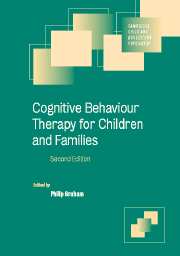Book contents
- Frontmatter
- Contents
- List of contributors
- 1 Introduction
- Part I Developmental cognitive theory and clinical practice
- Part II Engagement and assessment
- Part III Client groups
- Part IV Applications in psychosocial adversity
- Part V Applications in specific child and adolescent psychiatric disorders
- 12 Behavioural approaches to eating and sleeping problems in young children
- 13 Conduct disorders in young children
- 14 Attention deficit hyperactivity disorder
- 15 Children with developmental disabilities and their parents
- 16 Depressive disorders
- 17 Cognitive behavioural psychotherapy for obsessive compulsive disorders
- 18 Anxiety disorders
- 19 School refusal
- 20 Post-traumatic stress disorders
- 21 Disorders of eating control
- 22 Chronic fatigue syndrome
- 23 Children's interpersonal problems
- 24 Pain in childhood
- 25 Conduct disorders in adolescence
- 26 Drug and alcohol abuse
- Part VI CBT applications in preventive interventions
- Index
- References
14 - Attention deficit hyperactivity disorder
Published online by Cambridge University Press: 21 August 2009
- Frontmatter
- Contents
- List of contributors
- 1 Introduction
- Part I Developmental cognitive theory and clinical practice
- Part II Engagement and assessment
- Part III Client groups
- Part IV Applications in psychosocial adversity
- Part V Applications in specific child and adolescent psychiatric disorders
- 12 Behavioural approaches to eating and sleeping problems in young children
- 13 Conduct disorders in young children
- 14 Attention deficit hyperactivity disorder
- 15 Children with developmental disabilities and their parents
- 16 Depressive disorders
- 17 Cognitive behavioural psychotherapy for obsessive compulsive disorders
- 18 Anxiety disorders
- 19 School refusal
- 20 Post-traumatic stress disorders
- 21 Disorders of eating control
- 22 Chronic fatigue syndrome
- 23 Children's interpersonal problems
- 24 Pain in childhood
- 25 Conduct disorders in adolescence
- 26 Drug and alcohol abuse
- Part VI CBT applications in preventive interventions
- Index
- References
Summary
Restlessness, inattention and impulsiveness are common problems in children of school age and indeed in those of preschool years. When these problems are shown in extreme form, impairing the social and educational functioning of children involved, they can be considered to be signs of a psychiatric or psychological disorder. There are currently two major categorizations of such disorder. The first is that defined as Hyperkinetic Disorder in the International Classification of Diseases (ICD) (World Health Organization, 1994); this is the classification used in most European countries. Using this definition, approximately 1–2% of children of school age are affected (Danckaerts and Taylor, 1995). The second is that defined in the Diagnostic and Statistical Manual (DSM) of the American Psychiatric Association as Attention Deficit Hyperactivity Disorder (ADHD). There are less stringent criteria for the diagnosis of ADHD, and the prevalence rate is 3–5% of boys and 1–2% of girls. Nevertheless, ADHD is a chronic and impairing childhood mental health disorder (American Psychiatric Association, 1994). In this chapter, discussion of assessment and management will be based around the concept of ADHD.
Children with ADHD by definition present with abnormally high levels of inattention, impulsivity and hyperactivity, and these children often suffer substantial impairment in their daily life functioning in home, school and recreational settings. The behaviour of children with ADHD is often characterized as developmentally inappropriate and is now known to follow a developmental trajectory persisting into adolescence and adulthood.
- Type
- Chapter
- Information
- Cognitive Behaviour Therapy for Children and Families , pp. 225 - 243Publisher: Cambridge University PressPrint publication year: 2004



